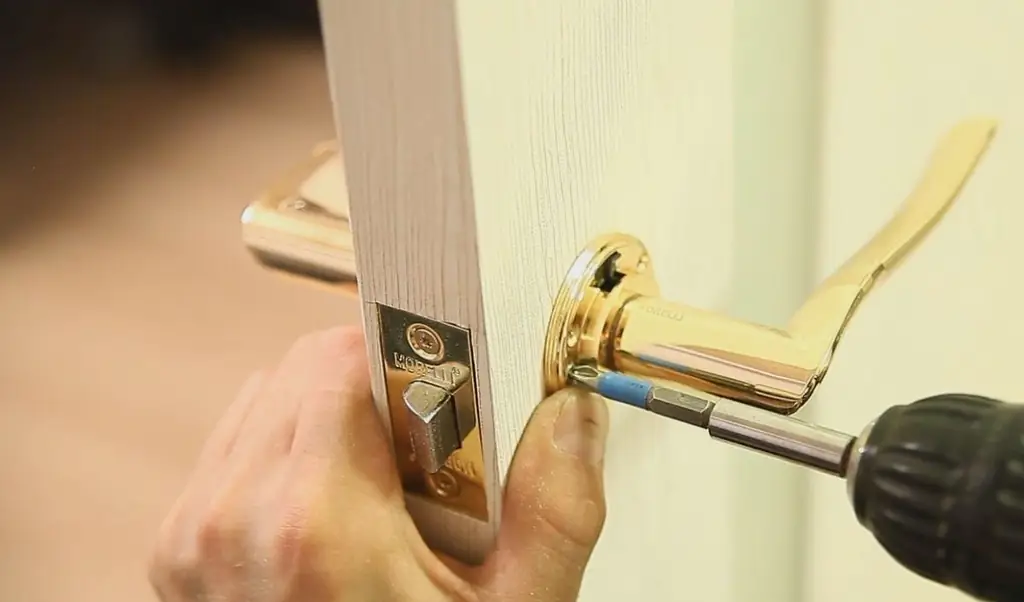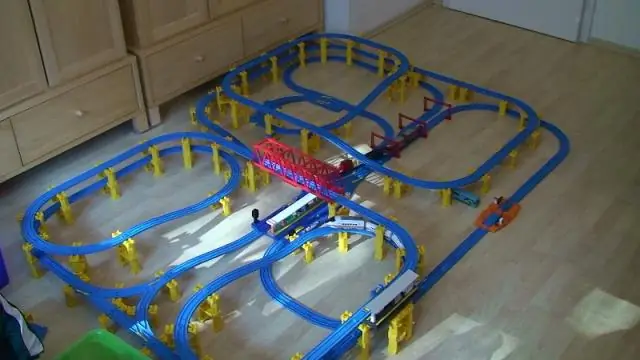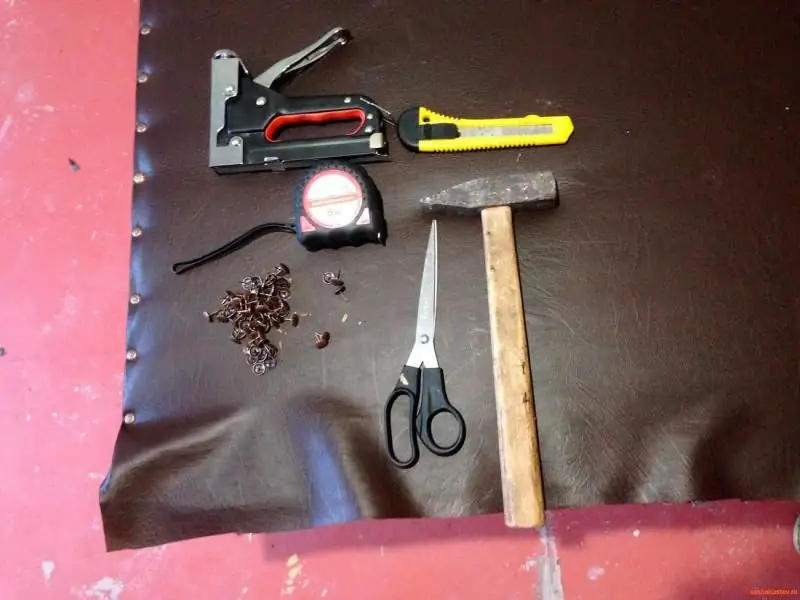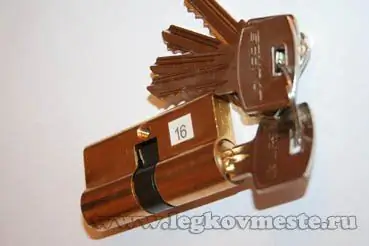
Table of contents:
- Author Bailey Albertson [email protected].
- Public 2023-12-17 12:53.
- Last modified 2025-06-01 07:32.
Replacing the door lock

At least once, every person is faced with the question of complete or partial replacement of a door lock. To effectively and cost-effectively solve the problem, you just need to carefully familiarize yourself with the types of locking devices and the assembly procedure for locking mechanisms.
Content
-
1 Types of door locks
- 1.1 Determining the type of lock
- 1.2 Most common causes of breakdowns
- 2 Required tools to replace the lock
-
3 How to independently replace the lock in the door
- 3.1 Video: replacing the Kale lock
-
3.2 How to change the larva on the lock
3.2.1 Video: how to replace the larva in the castle with your own hands
-
3.3 Replacing the lock case
3.3.1 Video: how to replace the lock on the front door
- 3.4 Adapting the new lock body to the existing holes
- 4 Reviews
Types of door locks
Locking devices are classified according to several criteria:
-
Three types are distinguished according to the installation method:
-
padlocks - the simplest type of lock, attached to special hinges or bows. They are used more often for utility rooms - storerooms, sheds, garages. Without a key, such locks are opened with a pry bar;

The padlock The strength of the padlock depends on the thickness of the shackle
-
overhead - installed on the inner surface of the door leaf, the counterpart is located on the frame. They are popular due to the ease of installation (they do not violate the integrity of the sash), are rarely used on metal doors. Designers avoid such mechanisms, since doors equipped with an overhead lock do not look very aesthetically pleasing;

Surface lock Most often, overhead locks are used as an additional lock on entrance doors.
-
mortise locks - they are mounted in the inner cavity of the door leaf; they are distinguished by their reliability and high resistance to burglary. They are massively used both on internal and on entrance doors. Concealed installation is an important advantage over other types of locks. They have a fine appearance. They are used on doors made of various materials - wood, plastic, metal.

Mortise lock Mortise locks are distinguished by their reliability and high level of secrecy
-
-
According to the security class (level of secrecy), locks are divided into four categories (estimated by the time required to open without a key):
- the first category includes mechanisms that can be broken in 2-3 minutes;
- the second includes locks that can be opened in 5 minutes;
- the third category consists of constipation, which will take a specialist at least 10 minutes to break;
- the fourth - the most reliable - will make even an experienced bugbear sweat for at least half an hour.
-
Internal structure and locking mechanism:
-
crossbar locks - differ from others in that they are opened by the translational movement of the key along the keyhole. On a long, rod-shaped wrench, oblique notches are milled, which control access to the swivel mechanism;

Crossbar lock The bolt lock is opened by pressing the key into the keyhole
-
Lever locks are a classic type, based on a combination of special code plates. It is almost impossible to physically destroy such a castle. The larger the number of levers (plates), the more difficult it is to pick up the master key. By the key, you can judge the degree of protection of the lock - the more slots on it, the more complex the coding mechanism;

Suvald castle Lever lock is considered the recognized leader among reliable locking mechanisms
-
cylinder locking mechanisms are the most common in the modern world. Due to the fact that forced opening is quite troublesome, and the size of the key is very compact, the lock is popular among the population of Europe and Asia. Among cylinder locks, the most reliable are those whose keys have lateral double-sided perforation;

Cylinder lock diagram The advantage of the cylinder lock is quick and easy cylinder change
-
electronic constipation. They are controlled by a set of characters (numbers and letters) on the introduction panel or using an electronic key. The principle of operation is similar to that of a car alarm. Today they are the most reliable locks;

Electronic lock The most reliable are electronic locks with an autonomous power source.
-
combination locks. The main visual sign is the absence of a key. If I may say so, the key is a combination of numbers stored in a person's head. The longer the cipher, the more reliable the lock. Often used in safes and secret rooms. The only drawback that experts note is that over time, frequently used symbols are overwritten on the buttons. And this will not escape the watchful eye of the intruder.

Code lock The key to the combination lock is impossible to lose
-
Determining the type of lock
For the convenience of users, the types of locks are determined by the shape and size of the key. There are catalogs and descriptions by which the type of the locking mechanism is determined by the method of visual comparison. For example, a flat key with teeth on one side and a longitudinal groove means that the lock belongs to a series of cylinders, in the common people called English.

The characteristic feature of the English key is the portable size
The cruciform shape of the key (like a four-sided screwdriver) with teeth indicates that it belongs to the ZV-704 lock type with three or two sliding bolts for interior, entrance or metal doors.

Each face of the key serves as a unique secret code for the lock
A pin wrench with two cut-out planes in the shape of a butterfly can belong to a locking mechanism of the CAM type (made in Russia) or an Italian lever lock CISA.

Lever wrench has a characteristic shape resembling a butterfly
The flat key with perforation is typical for MUL-T-LOCK (Israel) or KABA (Austria), etc.

Perforated flat keys are difficult to counterfeit without special equipment
An experienced master locker will at a glance determine the type and type of lock device, which will save time for the non-professional user
The most common causes of breakdowns
According to the data of specialized organizations, breakdown statistics (in descending order) are as follows:
- Malfunction of the slamming tongue. The reason lies in the mismatch in the dimensions of the outer hole on the counterpart, the displacement of the door leaf.
- Skewed frame and, as a result, incorrect door opening.
- Sticking and difficult turning of the key in the keyhole. This is caused by clogging of the larva or a chronic lack of lubrication.
- Jammed opening mechanism. A possible reason is wear of rubbing parts or destruction of return springs. Changing the geometric shape and breaking the key also leads to its jamming in the lock.
Less often, failure of the lock is associated with a breakdown of the case. Such situations arise due to mechanical impact, shock or overheating (for example, during a fire) of the metal parts of the lock.
Required tools to replace the lock
The vast majority of lock problems are solved with a screwdriver. But in the arsenal of the master there is always a set of files, an oiler and flushing fluid for locks. You need a rag to wipe off dust and remove excess grease, as well as spare parts - steel springs, larvae, replacement screws.

The main tool for repairing locks is a screwdriver
If the lock is jammed, an electric drill with a set of drills of various diameters will help to open it. In the event that you have to drill a larva, you will need a drill with a thickness of about 10 mm.

The larva is drilled with a large-diameter metal drill
If one type of lock is changed to another, a hydraulic level is needed for work, a measuring tool - a ruler, tape measure or vernier caliper and a pencil. The enlargement of the socket under the body is carried out using a drill or a router with an extended cutter.

Using an electric router, holes are drilled to replace locks
Sometimes you have to align the lock slot. In wooden doors, this is done with a chisel with a thin blade.
Based on my own experience, I note that the most difficult thing is the reinstallation of the lock in the doors, which were mounted in the dashing 90s of the last century. This is especially true for metal doors. In those days, there was not an abundance of unified locks on the market, each locksmith invented his own method of installation and fastening. As a result, the design acquired a bizarre configuration. For example, the famous Stirlitz lock, popular in garage cooperatives, consisted of two blocks - a secret locking system and a very complex safe-type lock. Having dared to replace such a device, you need to get ready to solve a difficult rebus. The usual practice in this case is to disassemble not only the locking mechanism itself, but also to completely dismantle the sheathing of the canvas.
How to change the door lock yourself
If there is a need to repair a door lock, you should understand that this is not a complicated matter, but it requires accuracy and attention to detail. It is possible to save on installation work and do without a specialist visit only if the lock is relatively simple. Expensive locks, especially of a lever design, protected by additional anti-burglary devices, are recommended to be repaired with the participation of a professional.
Video: replacing the Kale lock
How to change the larva on the lock
Replacement can be partial or complete, depending on the device of the locking mechanism. The simplest operation for cylinder models is the replacement of the core (or larva). It contains a coding mechanism that recognizes only the given key shape. Cylindrical inserts are opened with perforated flat keys or serrated keys. The operations are carried out with care and accuracy to avoid damage to the door. The procedure is simple and only requires a screwdriver:
-
The fastening screws on the plate at the end of the door leaf are unscrewed. If necessary, the door handles are first detached.

Larva replacement The larva can be removed only after removing the outer pads
-
The screw securing the larva is unscrewed.

Replacing the door cylinder The fixing screw is located at the end of the door
-
A key is inserted into the keyhole and rotated 15-20 ° until the insert is completely free.

Removing the door cylinder Turning the key causes the rotary cam to move
- The dimensions of the new part must exactly match the dimensions of the old liner. The core is placed in the hole and screwed down a little with a screw.
- If after that the lock works easily and freely rotates the pivot tongue, the replacement cartridge is finally fixed, tightening the fixing screw as much as possible.
- After that, check the operation of the lock again and install the handles with protective pads.
Video: how to replace a larva in a castle with your own hands
Replacing the lock body
Replacing the larva does not always solve the problem. Firstly, not all castles have it. Second, sometimes the damage involves other mechanisms. In such cases, the lock is completely changed. This happens in the following order:
-
The door handles are dismantled. In older models, the handles are interconnected by a quadrangular rod with a cotter pin. It must be bent and removed from the hole. The new door handles are secured with a screw, which is unscrewed with a thin (2.5-3 mm) Allen key.

Removing the door handle The locking screw is located on the inner handle body
- The larva is removed as described above.
-
On the end part of the blade there are screws that hold the lock. They are unscrewed with a screwdriver.

Removing the door lock Low speed electric drill or screwdriver speeds up the disassembly process
-
The case is taken out of the socket and a replacement is selected according to its size. Ideally, the new device should be completely identical to the original. When buying, you should pay attention to the linear dimensions of the case, the thickness and the location of the attachment points. The surest way not to make a mistake is to take the old castle with you and choose exactly the same one in the store.

Replacing the door lock An exact replica of the locking mechanism ensures success when replacing the device body
- Installation is carried out in the reverse order - the new body is installed and fixed in its original place, the larva returns to its previous position and, finally, the door handles are attached. As a rule, all fasteners are included in the set of a new lock, it is recommended to use it.
Video: how to replace the lock on the front door
Adaptation of the new lock body to the existing holes
Factory made locks cannot be adjusted. Body dimensions are unchanged. Therefore, for replacement, it is important to choose an absolutely equivalent analogue. If this is not possible and you have to install a larger or smaller lock, it is worth considering the option of adjusting the socket in the door leaf to the dimensions of the new mechanism.

The markings for the recess are strictly symmetrical
The enlargement of the cavity in a wooden door is carried out using chisels or an electric router. As a last resort, a drill with a large diameter drill is used. Expanding the socket is not recommended, as this will weaken the doors. Without compromising strength, you can only deepen the locking groove. When performing work, it is advisable to maintain the dimensions of the hole for a new lock with an error of no more than 0.5-1 mm. If the body "dangles" in the door, you can seal its fit with thin wooden plates.

Electric router significantly increases labor productivity
The classic nest expansion algorithm consists of three operations:
-
Complete dismantling of the old castle. For convenience, it is recommended to remove the sash from the hinges.

The procedure for dismantling the castle Replacing the lock begins with disassembling all parts from the doors
- Drilling a keyway for a new lock. The hole is carefully centered, finding the middle of the end in the longitudinal and transverse axes.
-
Fitting a new building. If the result is satisfactory and the lock fits snugly in the socket, it is fixed with screws. Further - the assembly according to the points given above.

Increasing the keyway The new lock should fit into the recess with minimal clearance
You may have to not only deepen the groove, but also offset the hole for the core. In this case, the position of the larva is calculated in such a way that the door handles cover the hole from the old lock.
Reviews
Although repairing the castle is a simple task and any person can do it, getting down to work, you need to be patient. The quality of replacement depends not only on the further comfort of using the door, but also on the safety of property, safety of living. In the event of a tamper, a carelessly installed mechanism can be prohibitively expensive.
Recommended:
How To Choose An Acrylic Bathtub: Expert Advice, Manufacturer Analysis And Customer Reviews + Video

Advantages of acrylic bathtubs and their disadvantages. How to choose a quality bathtub: ways to check the thickness, smoothness of acrylic; nuances. The best manufacturers and models
How To Choose A Good Quality Travel Suitcase On Wheels: Expert Advice + Videos And Reviews

The safety of things is one of the conditions for a successful trip. How to choose a good suitcase on wheels, what subtleties to consider if it is a travel bag for a child
How To Wean A Cat From Shitting In The Wrong Place: Reasons Why A Cat Or Kitten Ignore The Tray, Expert Advice And Folk Methods

Why does a cat go to the toilet in the wrong place: illness, jealousy, resentment, discomfort. Where to put the tray. How to train your cat to walk only in the litter box
Door Upholstery With Dermantine: Choice Of Material, Tools And Stages Of Work

What is leatherette, its features, advantages and disadvantages. How to choose a material. Different methods of upholstering the door with leatherette and the order of work
Replacing The Lock Cylinder. - How To Quickly Change A Door Lock Cylinder

Is it quick and easy to replace the cylinder in the door? Step-by-step instructions for replacing the larva in the door lock
